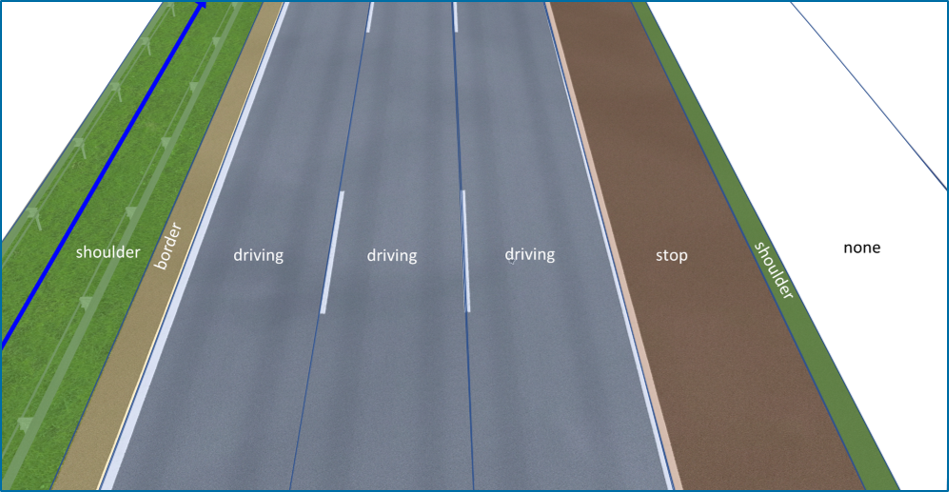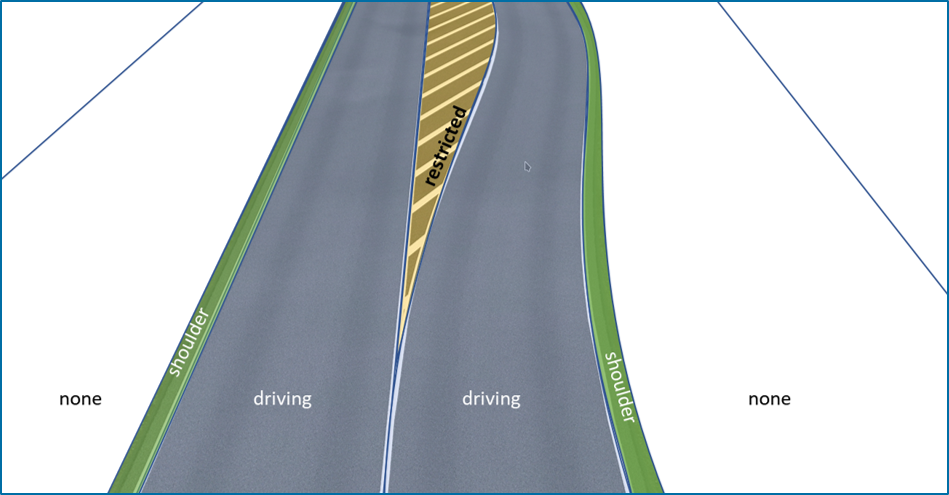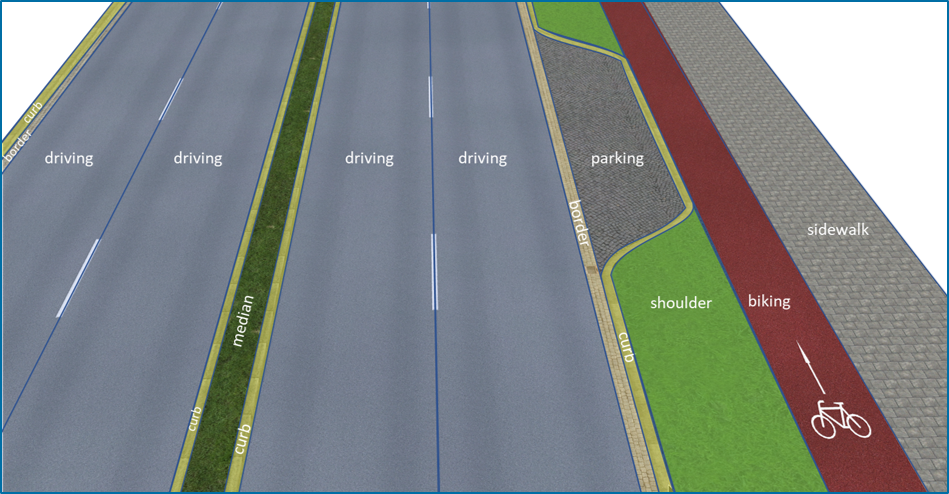车道类型:
9.5.3. Lane type 车道类型
The lane type is defined per lane. A lane type defines the main purpose of a lane and its corresponding traffic rules.
每条车道都会被定义一个类型。车道类型定义了车道的主要用途及与其相对应的交通规则。
The available lane types are:
-
shoulder: Describes a soft border at the edge of the road.
-
border: Describes a hard border at the edge of the road. It has the same height as the drivable lane.
-
driving: Describes a "normal" drivable road that is not one of the other types.
-
stop: Hard shoulder on motorways for emergency stops
-
none: Describes the space on the outermost edge of the road and does not have actual content Its only purpose is for applications to register that OpenDRIVE is still present in case the (human) driver leaves the road.
-
restricted: Describes a lane on which cars should not drive. The lane has the same height as drivable lanes. Typically, the lane is separated with lines and often contains dotted lines as well.
-
parking: Describes a lane with parking spaces.
-
median: Describes a lane that sits between driving lanes that lead in opposite directions. It is typically used to separate traffic in towns on large roads.
-
biking: Describes a lane that is reserved for cyclists.
-
sidewalk: Describes a lane on which pedestrians can walk.
-
curb: Describes curb stones. Curb stones have a different height than the adjacent drivable lanes.
-
exit: Describes a lane that is used for sections that are parallel to the main road. It is mainly used for deceleration lanes.
-
entry: Describes a lane type that is used for sections that are parallel to the main road. It is mainly used for acceleration lanes.
-
onramp: A ramp leading to a motorway from rural or urban roads.
-
offRamp: A ramp leading away from a motorway and onto rural urban roads.
-
connectingRamp: A ramp that connects two motorways, for example, motorway junctions.
可用的车道类型有:
-
路肩shoulder:描述了道路边缘的软边界。
-
边界border:描述了道路边缘的硬边界。其与正常可供行驶的车道拥有同样高度。
-
驾驶driving:描述了一条“正常”可供行驶、不属于其他类型的道路。
-
停stop:高速公路的硬路肩,用于紧急停车。
-
无none:描述了道路最远边缘处的空间,并无实际内容。其唯一用途是在(人类)驾驶员离开道路的情况下,让应用记录OpenDRIVE仍在运行。
-
限制restricted:描述了不应有车辆在上面行驶的车道。该车道与行车道拥有相同高度。通常会使用实线以及虚线来隔开这类车道。
-
泊车parking:描述了带停车位的车道。
-
分隔带median:描述了位于不同方向车道间的车道。在城市中通常用来分隔大型道路上不同方向的交通。
-
自行车道biking:描述了专为骑自行车者保留的车道。
-
人行道sidewalk:描述了允许行人在上面行走的道路。
-
路缘curb:描述了路缘石。路缘石与相邻的行车道在高度有所不同。
-
出口exit:描述了用于平行于主路路段的车道。主要用于减速。
-
入口entry:描述了用于平行于主路路段的车道。主要用于加速。
-
加速车道onramp:由乡村或城市道路引向高速公路的匝道。
-
减速车道offRamp:驶出高速公路,驶向乡村或城市道路所需的匝道。
-
连接匝道connectingRamp:连接两条高速公路的匝道。例如高速公路路口。
For the use of the lane types, see figure 64 to figure 68.
关于车道类型的使用,请见图64到图68。





In OpenDRIVE, lane types are represented by the attribute @type element within the <lane> element.
在OpenDRIVE中,车道类型用<lane>元素内属性@type元素来表示。
Attributes 属性
t_road_lanes_laneSection_lr_lane
Lane elements are included in left/center/right elements. Lane elements should represent the lanes from left to right, that is, with descending ID.
车道元素元素被包括在左/中/右元素元素中。车道元素元素应(should)按降序ID从左到右展示车道。
|
attributes |
name |
type |
unit |
value |
Description |
|
|
e_laneType |
Type of the lane. For values see UML model. 车道类型。关于值请见UML 模型。 |
|||
|
|
t_bool |
"true" = keep lane on level, that is, do not apply superelevation; "false" = apply superelevation to this lane (default, also used if attribute level is missing) "真true" = 将车道保持在水平, 也就是说不要采用超高程; "伪false" = 对此车道采用超高程 (为默认设置, 若属性水平缺失时也可用) |
Rules 规则
The following rules apply to lane types:
-
The lane type may be changed as often as needed by using a new lane section.
以下规则适用于车道类型:
-
可(may)通过使用新的车道段根据需要多次地更改车道类型。